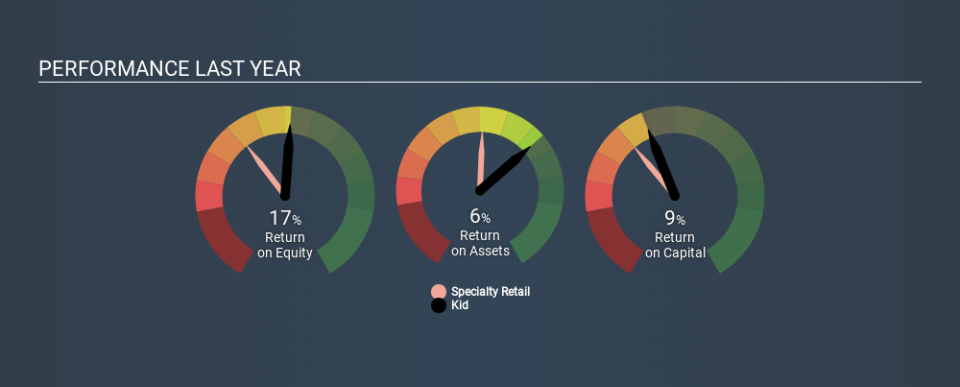Is Kid ASA’s (OB:KID) 9.4% Return On Capital Employed Good News?

Today we are going to look at Kid ASA (OB:KID) to see whether it might be an attractive investment prospect. Specifically, we'll consider its Return On Capital Employed (ROCE), since that will give us an insight into how efficiently the business can generate profits from the capital it requires.
First of all, we'll work out how to calculate ROCE. Then we'll compare its ROCE to similar companies. Then we'll determine how its current liabilities are affecting its ROCE.
What is Return On Capital Employed (ROCE)?
ROCE measures the amount of pre-tax profits a company can generate from the capital employed in its business. All else being equal, a better business will have a higher ROCE. In brief, it is a useful tool, but it is not without drawbacks. Renowned investment researcher Michael Mauboussin has suggested that a high ROCE can indicate that 'one dollar invested in the company generates value of more than one dollar'.
How Do You Calculate Return On Capital Employed?
Analysts use this formula to calculate return on capital employed:
Return on Capital Employed = Earnings Before Interest and Tax (EBIT) ÷ (Total Assets - Current Liabilities)
Or for Kid:
0.094 = kr226m ÷ (kr3.2b - kr796m) (Based on the trailing twelve months to June 2019.)
Therefore, Kid has an ROCE of 9.4%.
See our latest analysis for Kid
Is Kid's ROCE Good?
ROCE is commonly used for comparing the performance of similar businesses. Using our data, Kid's ROCE appears to be around the 9.4% average of the Specialty Retail industry. Aside from the industry comparison, Kid's ROCE is mediocre in absolute terms, considering the risk of investing in stocks versus the safety of a bank account. It is possible that there are more rewarding investments out there.
In our analysis, Kid's ROCE appears to be 9.4%, compared to 3 years ago, when its ROCE was 7.2%. This makes us think the business might be improving. You can see in the image below how Kid's ROCE compares to its industry. Click to see more on past growth.
Remember that this metric is backwards looking - it shows what has happened in the past, and does not accurately predict the future. Companies in cyclical industries can be difficult to understand using ROCE, as returns typically look high during boom times, and low during busts. ROCE is, after all, simply a snap shot of a single year. Since the future is so important for investors, you should check out our free report on analyst forecasts for Kid.
How Kid's Current Liabilities Impact Its ROCE
Liabilities, such as supplier bills and bank overdrafts, are referred to as current liabilities if they need to be paid within 12 months. The ROCE equation subtracts current liabilities from capital employed, so a company with a lot of current liabilities appears to have less capital employed, and a higher ROCE than otherwise. To counter this, investors can check if a company has high current liabilities relative to total assets.
Kid has total liabilities of kr796m and total assets of kr3.2b. Therefore its current liabilities are equivalent to approximately 25% of its total assets. This is a modest level of current liabilities, which would only have a small effect on ROCE.
What We Can Learn From Kid's ROCE
With that in mind, we're not overly impressed with Kid's ROCE, so it may not be the most appealing prospect. You might be able to find a better investment than Kid. If you want a selection of possible winners, check out this free list of interesting companies that trade on a P/E below 20 (but have proven they can grow earnings).
For those who like to find winning investments this free list of growing companies with recent insider purchasing, could be just the ticket.
If you spot an error that warrants correction, please contact the editor at editorial-team@simplywallst.com. This article by Simply Wall St is general in nature. It does not constitute a recommendation to buy or sell any stock, and does not take account of your objectives, or your financial situation. Simply Wall St has no position in the stocks mentioned.
We aim to bring you long-term focused research analysis driven by fundamental data. Note that our analysis may not factor in the latest price-sensitive company announcements or qualitative material. Thank you for reading.

 Yahoo Finance
Yahoo Finance 
